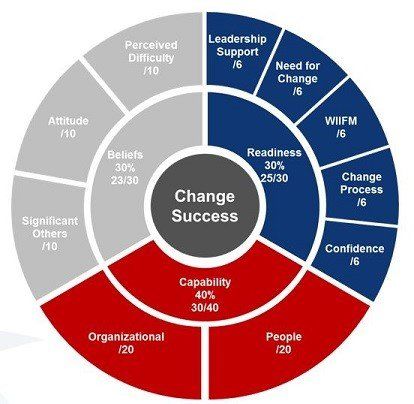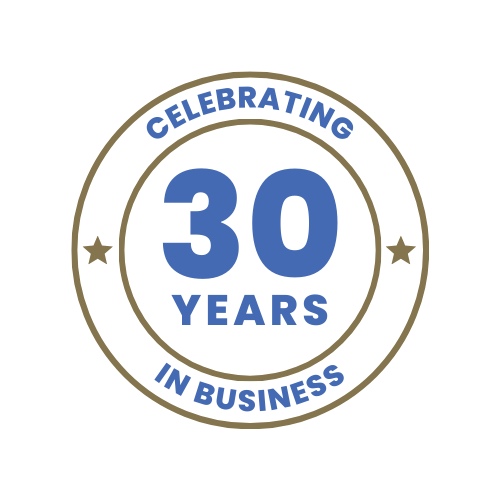Change Initiative Success: What are the 10 Key Factors?
- By geff@wsielevateddigital.com
- •
- 02 Jun, 2018
- •
“Healthy Organization” Foundation #5: Growing and Profitable.
The world is changing rapidly. Some markets are living with “hyper-competition”, not just your every day, annoying competition. The ability to quickly implement effective change initiatives as market conditions demand has become a key component of your Sustainable Competitive Advantage. Yet, if you run a Google search on “change initiatives success”, you’ll find countless articles that remind us that more than 70% of change initiatives fail or never come close to their intended level of success. The cost to organizations is tremendous! What can you do to make sure your organization is “tuned up” to effectively launch and implement a successful change initiative?
Recent research* resulted in a model that shows 10 factors in 3 main categories define the probability of success for any given initiative. The 3 categories of organizational behavior and structure contributing to change success are:
- Readiness (30%): How ready the organization and the people within the organization are to implement change.
- Capability (40%): The skills, people, training and resources needed to implement change.
- Beliefs (30%): The overall attitude of the organization in relation to the change.

All of the factors are interrelated and contribute to the ultimate potential for success. Using this framework, you can analyze where the “gaps” are in your organizational readiness for launching any major change initiative. Or, you can do what many organizations do and set a change process in place without ensuring all of these factors have been addressed.
With banners flying and troops assembled, you engage in battle. (And battle it is! The hardest thing you will ever do as a manager or leader is to try to change an organization.) You experience enthusiasm and progress and then, the inevitable setbacks. After a period of time, which may literally be years, the tendency is to take whatever gains have been won, declare victory and move on to the next battle.
This “seat-of-the-pants” approach is very costly both in financial and people terms. If, however, you can improve each of the 10 elements in the change success model BEFORE launching the initiative, the probability of success is likely to rise significantly above the normal 30% benchmark resulting in lower costs, faster implementation and improved team morale and confidence. The challenge for leaders is to identify where the key gaps are in the 10 elements and to put in place specific action plans and key performance indicators to bridge those gaps. Are you up to the task?
A detailed video explanation of the model by the researcher can be found at change success model
*Mason, C. L. (2014). “A Mixed Methods Study on How Change Intentions and Change Readiness Predict Organizational Change Success”
Other Posts

I recently posted an article published in Forbes about T. Boone Pickens, famous for an active entrepreneurial life and his book, The First Billion is the Hardest . Every year around this time, he’s asked to share his wisdom, gathered over many decades, with some college graduating class in the U. S. The Forbes article includes six “Booneisms” he’s known for, but the one I like the most is, “A fool with a plan can beat a genius with no plan.”
Although the CEOs and senior managers I regularly work or interact with are certainly NOT fools, all too often they’re working without a plan. While it may be okay on Saturday to get up and “let the day take you”, that’s not a good recipe for business, large or small. Too much is at stake!
The ideal planning sequence takes place in the context of shared values and a true team of managers committed to each other AND a common goal. (I’ve often said to management teams, “You don’t have to like each other, but you MUST be able to communicate effectively and solve problems together as you work to achieve your objectives.”)


Yesterday, a friend and colleague said she was having trouble “holding herself accountable”. She wasn’t getting things done that she thought she should be, including some things she deemed important to the business. For perspective, this woman is running a business, supervising a stable workforce and keeping multiple clients happy. On top of all that, she’s a mom! (Can you say “busy”?)
The conversation quickly went to a few questions:
- What are you not achieving?
- Where’s the breakdown?
- What are your goals?


Effective communication is one of the key functions of management, yet we frequently find ourselves frustrated with others not understanding what we have shared. After we say our piece, we assume that others see things the same way we do but the only thing we can be sure of, even after a lengthy conversation, is that what’s in your mind is not exactly the same in their mind. We just hope the gaps are few and insignificant.
The problem is even worse if the communication comes in the form of a management “presentation” with little/no opportunity for dialogue. I once spent an hour presenting “how we make money” to a group of front-line employees: Revenue – (Material + Labor + Manufacturing Overhead + Other Overhead) = Profit. The presentation was complete with flipchart graphics. It was clear from some of the questions at the end of the presentation that some of the employees still looked at Revenue as the amount of money theoretically distributable to all the members of the company. While frustrating, this incident just confirmed how hard it is to be truly effective in your communication. Also, it’s important to keep in mind that the primary responsibility for the effectiveness of communication lies with whoever is sending the message.
Studies have shown that managers typically under communicate but think they did a good job. It’s not just executive management. This “failure to communicate” affects all members of an organization. If you are a middle manager, you have the challenge of communicating both up and down the chain of command. If you are a front-line team member, it’s important you effectively communicate any issues or challenges you face in the performance of your job so they may be resolved. Anything less than excellent communication, at all levels, negatively impacts relationships and hurts the bottom line.
Here’s a formula for communication success:
- Preparation:
- Understand your objective. Why are you communicating?
- Understand your audience. What do they need to know?
- Plan what you want to say.
- Choose the best communication channel:
- One-on-one conversation
- Team presentation/discussion
- Written document:
- Match your style to reader’s preferences
- Avoid jargon or slang
- Check your grammar and punctuation
- Check for tone and attitude
- Email/text for simple directions (NEVER email/text complex or negative content.)
- Consider:
- Cultural context of organization
- Potential emotional content
- Need for detail
- The need to ask and answer questions
- Draft:
- Decide exactly what to convey.
- As much as possible, use pictures, charts, diagrams.
- Verbal: prepare written notes to guide the conversation.
- Written: draft document/presentation for sharing. Review as necessary to ensure effectiveness. Send.
- If sensitive, solicit other inputs and get feedback prior to sending/engaging.
- Engage (Verbal):
- Be concise.
- Listen actively.
- Stay open.
- Be attentive and avoid distractions.
- Respect others’ feelings
- Don’t interrupt!
- Pay attention to body language.
- Ask questions to ensure understanding.
- Record all action items: What-Who-When.
- Follow Up:
- How effective was the communication?
- Did I/we achieve the stated objectives?
- What could we do to improve communication?
Effective communication is an art that all of us would do well to master, for our own good and that of our organization. Are you getting the results you want from your communication or are you constantly thinking, “Why don’t they get it?”
Comer and Associates, LLC develops great leaders and teams and facilitates projects that lead to growth and profit. Our April 11 – 13 ADVANCE management and leadership workshop will cover all the key functions of management, including communication.
